Millar, Sean (2022) Irish findings from the European Web Survey on Drugs. Drugnet Ireland, Issue 83, Winter 2022, pp. 1-5.
| Preview | Title | Contact |
|---|---|---|
|
PDF (Drugnet Ireland 83)
741kB |
The National Drug and Alcohol Survey (NDAS) has been conducted five times in Ireland.1 However, although the NDAS provides prevalence rates regarding drug use, it can only collect robust information on patterns of use for the more commonly used drugs, such as cannabis. It does not collect data from a sufficiently large sample of people who use drugs to provide reliable information on patterns of use for less frequently used drugs such as ecstasy, amphetamines, and new psychoactive substances (NPS).
The European Monitoring Centre for Drugs and Drug Addiction (EMCDDA) has developed the European Web Survey on Drugs (EWSD) to collect data from a wide range of people who use drugs. In 2021, Ireland participated in the EWSD for the first time. The rationale for this was to generate new data on patterns of drug use, as set out in Action 5.1.45 of Ireland’s National Drugs Strategy. The data collected provided information on:
- The frequency of drug use by drug type
- Drug use patterns according to sex and age
- The reasons why people use drugs, by drug type
- The main sources used to obtain drugs
- The impact of the Covid-19 pandemic on drug use.
The 2021 Irish EWSD was an online, convenience, non-probability survey. The study population included people aged 18 years and over, who lived in Ireland, and who had used drugs in the previous 12 months. A total of 27,001 web users clicked onto the Irish EWSD survey link and landed on the homepage of the survey: 8,104 web users agreed to participate in the survey, of whom 5,796 were eligible. The main findings from the Irish EWSD are discussed below.2
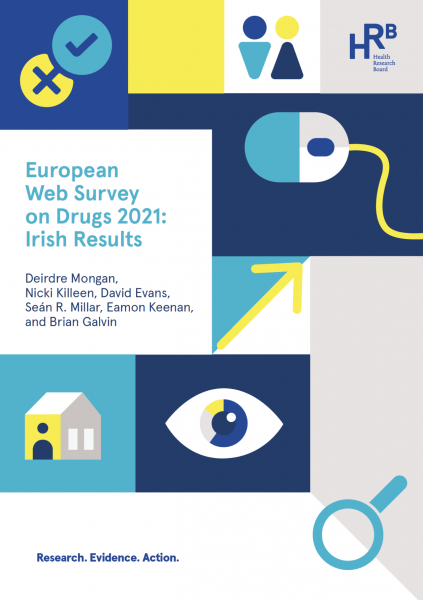
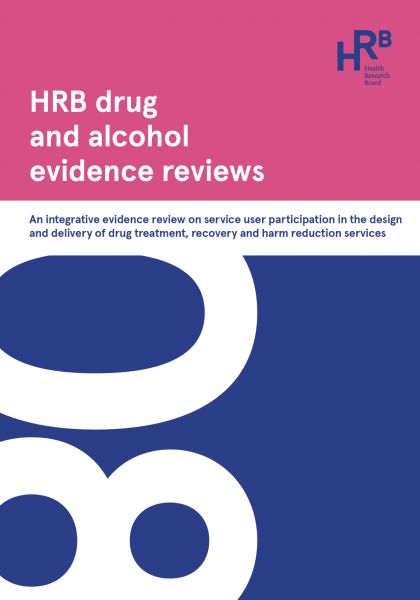
Last-year and last-month drug use
Last-year and last-month use of each drug is presented in Table 1. Cannabis was the drug most commonly used in the last year (91%), followed by cocaine (49%) and ecstasy (31%). The proportion of respondents reporting last-year ketamine use was also high (24%). For most drugs, the proportions of males and females reporting use were similar; however, males were more likely than females to report last-year and last-month use of magic mushrooms and LSD.
For most drugs, last-year and last-month use varied by age group. While there was little difference in cannabis use between age groups, younger respondents were more likely than older respondents to report use of stimulants such as cocaine and ecstasy. One-third (34%) of 18–24-year-olds reported last-year ketamine use, compared with 20% of 25–34-year-olds, 9% of 35–44-year-olds, and 5% of those aged 45 years and over. The top three most commonly used drugs in the last year were the same for each age group; however, older respondents were more likely to use amphetamines and magic mushrooms, while ketamine was more commonly used among younger age groups (see Figure 1).
More than one-third (36%) of respondents reported use of one drug in the last year, while 44% reported using at least three different drugs in the last year. Males were more likely than females to have used three or more drugs in the last year (46% vs 41%), while those aged 18–24 years were most likely to have used three or more drugs in the last year (53%).
Reasons for using drugs
The main reasons respondents used drugs varied by drug type. The primary reason for using cannabis (all types) was to reduce stress (80%), while getting high was the primary reason for using cocaine, ecstasy, amphetamines, and NPS (see Figure 2). Males were more likely than females to use cannabis to get high (79% vs 69%) and to socialise (50% vs 41%). A high proportion of cannabis users reported using cannabis to treat a number of physical and mental ailments: 46% used it to treat depression or anxiety and 32% used it to reduce pain. Older respondents (aged 35 years and over) were most likely to use cannabis to reduce pain (42%) and were least likely to use it in order to get high (67%) or to socialise (34%). Amphetamines were the drug most commonly used to enhance performance, with 26% of respondents using them for this purpose. NPS users were much more likely than users of other drugs to cite curiosity as a reason for use (58%).
How drugs are sourced
Those who had purchased drugs in the last year were asked what methods they usually used to do so. For each drug, with the exception of NPS, the majority of users typically obtained the drug through direct contact with their source (see Figure 3). Social media was used by 22% of cannabis herb users; however, this decreased to 7% among amphetamine users. The darknet was most commonly used by those purchasing NPS (20%); in comparison, just 3% of cocaine users obtained cocaine using the darknet.
Table 1: Last-year and last-month drug use among respondents, by sex
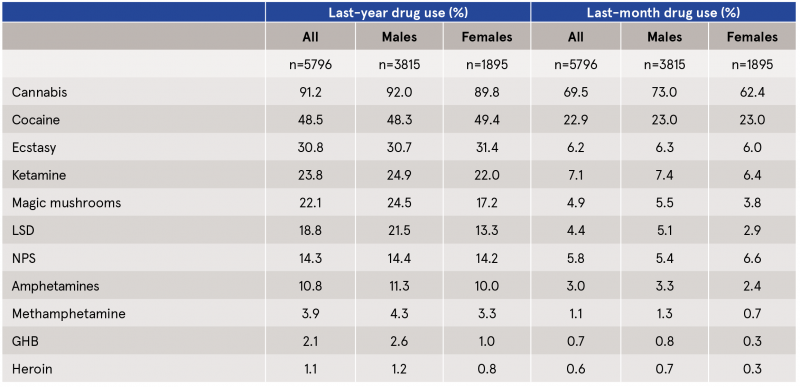
Source: EWSD, 2022
NPS: new psychoactive substances; GHB: gamma-hydroxybutyrate

Source: EWSD, 2022
Figure 1: Drugs most commonly used in the last year, by age group
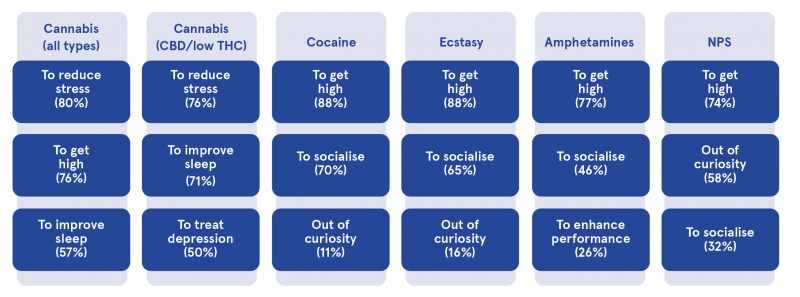
Source: EWSD, 2022
CBD: cannabidiol; THC: tetrahydrocannabinol; NPS: new psychoactive substances.
Note: Respondents could select more than one option.
Figure 2: Top three reasons for using drugs, by drug type
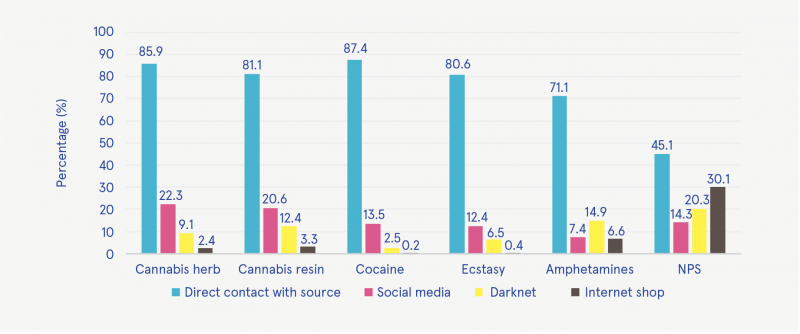
Source: EWSD, 2022
NPS: new psychoactive substances.
Note: Respondents could select more than one option.
Figure 3: Methods used to buy drugs among those who bought drugs in the last year, by drug type
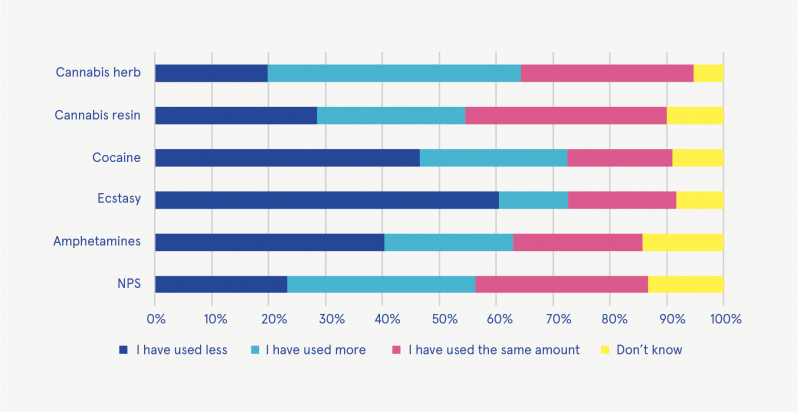
Source: EWSD, 2022
NPS: new psychoactive substances.
Figure 4: Change in drug use due to the Covid-19 pandemic, by drug type
Impact of Covid-19 pandemic on drug use
In each of the EWSD modules, respondents were asked if their use of that drug had changed as a result of the Covid-19 pandemic. A high proportion of respondents reported using less ecstasy (61%), while 12% reported increased use. In comparison, just 20% of cannabis herb users reported reduced use, while 45% reported increased use. One-third (33%) of NPS users and one-quarter (26%) of cocaine users also reported increased use (see Figure 4).
Conclusions
The report authors note that when interpreting the Irish EWSD results, it is important to acknowledge that they are likely to have been influenced by the Covid-19 pandemic and the resultant restrictions on movement that arose from it. The finding that 24% of respondents indicated that they had used ketamine in the last year is of particular interest, as this is considerably higher than the overall proportion reported by the EMCDDA (13%).3 This suggests that ketamine use should be included in future NDAS surveys in Ireland. The last-year prevalence of cocaine use was also high among Irish EWSD respondents at 49%, compared with 34% among the entire European EWSD sample.3 In their conclusion, the EWSD report authors suggest that online surveys may be a useful tool for collecting information on patterns of drug use from a large number of people, both quickly and cost-effectively, and that online surveys may complement other traditional data sources such as general population and school surveys.
1 Mongan D, Millar SR and Galvin B (2021) The 2019–20 Irish National Drug and Alcohol Survey: main findings. Dublin: Health Research Board. https://www.drugsandalcohol.ie/34287/
2 Mongan D, Killeen N, Evans D, Millar SR, Keenan E and Galvin B (2022) European Web Survey on Drugs 2021: Irish results. Dublin: Health Research Board. https://www.drugsandalcohol.ie/36571/
3 European Monitoring Centre for Drugs and Drug Addiction (2022) European Web Survey on Drugs 2021: top level findings, 21 EU countries and Switzerland. Luxembourg: Publications Office of the European Union. https://www.drugsandalcohol.ie/35518/
B Substances > Cannabis / Marijuana
B Substances > CNS stimulants > Amphetamines
B Substances > CNS stimulants > MDMA / Ecstasy
B Substances > Cocaine
B Substances > New (novel) psychoactive substances
F Concepts in psychology > Motivation
G Health and disease > Disease by cause (Aetiology) > Communicable / infectious disease > Viral disease / infection > Coronavirus (COVID-19)
VA Geographic area > Europe
VA Geographic area > Europe > Ireland
Repository Staff Only: item control page